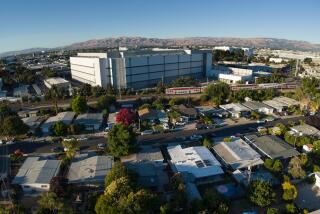TECHNOLOGY : Scottsdale Vies for Big Boost From NASA’s Vast Databases
- Share via
SCOTTSDALE, Ariz. — For decades, the National Aeronautics and Space Administration made the nation proud by sending Americans to the moon and launching legions of robot vehicles and satellites into orbit and to other worlds.
But a series of failures, including the shuttle Challenger disaster and the faulty Hubble Space Telescope, and the end of the Cold War changed that, prompting many to ask whether it made sense to foot the bill for any space program simply for its prestige value.
In the face of dwindling budgets, NASA now is taking aim at earthly problems by making the terabytes upon terabytes of data it has gathered in space over the last 30 years available to the public. The goal is to stimulate economic growth and improve the quality of life and education for those who foot the bill for the nation’s space programs--the American taxpayers.
This booming Arizona resort community of well-landscaped lawns, golf course fairways and Western-style stucco homes is competing to be among the first to benefit from NASA’s new High Performance Computing and Communications Program.
More than 400 communities, high-tech corporations, school districts and farming businesses across the nation have submitted proposals for using NASA’s vast databases via the Internet, a system of more than 7,000 networks linking 1 million host computers and 8 million users that is paving the way for the “information superhighway.”
NASA stopped accepting proposals for the pilot project on Monday, and winners of the coveted cooperative agreements will be announced sometime in July.
Given the challenges ahead, it is no wonder that Scottsdale is vying for the prize.
It was born a dusty, one-square-mile hamlet of 2,000 people in 1951, and has mushroomed into a 185-square-mile city of 165,000 people that attracts 5 million snowbirds a year.
Scottsdale officials say they need all the help they can get to accommodate business and residential growth without destroying the surrounding Sonoran Desert landscape of scenic mountains, boulder outcroppings and Saguaro cactus forests.
Here, change is magnified at the interface between urban development and fragile desert terrain. Here, too, data collected by remote sensing equipment aboard satellites about plants, soil, air, water, wind, rain and even lightning strikes in the region would be invaluable in determining, for example, where best to put a new road or a relocated business.
Instead of dispatching survey crews to map plans for a hiking trail, planners could request the relevant data from NASA and, with a click of a computer mouse, receive everything they need to make an informed decision.
“Shaping the future of a rapidly growing community such as ours means coming up with short- and long-term strategies,” Scottsdale City Manager Richard Bowers said.
“This tool would allow us to play out an array of future scenarios,” he added. “It could also make us more competitive than other communities in terms of attracting corporations looking for a place to set up technology centers.”
Bowers also has high hopes that securing a cooperative agreement with NASA could spark new interest in a proposed space science center for Scottsdale that has suffered from a lack of focus and financing.
That project was falling apart until Scottsdale hired former aerospace engineer and space exploration enthusiast Wil Orr a year ago to pick up the pieces and round up financial partners ranging from school districts to high-tech industries.
“It’s incredibly exciting for us,” Orr said. “And it heralds a new era for NASA. After 30 years of exploring outer space, NASA is coming home.”
And NASA may have more to gain from the program than the communities that want to tap into its databases at barely more than the cost of placing a long-distance telephone call.
Paul Hunter, program manager of the space agency’s new information service, said that “the hope is that, as these applications start to become visible and public, more and more people will see that NASA missions are relevant to everyday life.”
More to Read
Sign up for Essential California
The most important California stories and recommendations in your inbox every morning.
You may occasionally receive promotional content from the Los Angeles Times.














